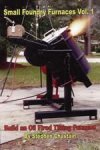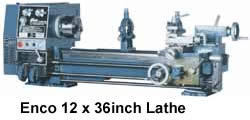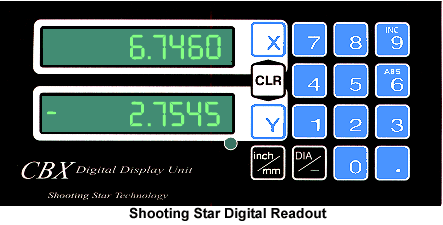Lathe and DRO ReviewProduct Review: Enco 12 x 36inch Lathe and Shooting Star Digital Readout.Copyright © Stephen Chastain The following article ran in Home Shop Machinist Magazine a few years ago. I am still using the lathe and digital readout. They have produced good work for years. It was December of 92, I had been reading HSM for about six months and decided I couldn’t live another minute longer without a lathe. There was a problem. I knew nothing about metal working equipment because my total shop experience consisted of a few woodworking projects on a Sears tablesaw. I had recently purchased an Enco woodworking jointer for $239 and was very happy with the quality relative to other jointers in that price range so I decided to look at their metal working equipment. After several sleepless nights I decided on an Enco 13 x 40 lathe. It was about $2400. I arrived at the showroom in Tampa to find model 110-2078 (current model # AP110-2078); a 12 x 36 inch geared head lathe on sale for just over $2000. The salesman easily talked me into the 12-inch lathe. We loaded it into my truck and I drove home. One of my friends delivers fork trucks for Caterpillar. When he was making a call in my area he stopped by to unload the lathe and put it in my garage. I now had a lathe. I didn’t know how to turn it on, but I had one.
I uncrated the lathe to find it covered with protective grease. The grease was easily removed with kerosene, a brush and a rag. I set up the stand that comes with the lathe and used an engine hoist borrowed from the local auto parts store to set it on the stand. I carefully leveled the lathe and hooked up the power cord. After studying the manual, I found the “on” switch and turned it on. The lathe ran about 20 seconds and the breaker tripped. I carefully reviewed all the wiring, however a few more tries got the same result. I called Enco and they immediately sent a new “made in USA” motor at no cost, no questions asked. They also gave me a technical help number where the attendant walked me through the wiring of the new motor. I quickly had the new motor installed and the lathe up and running. There have been no problems in the last nine years. “Made in USA” motors are now shipped as standard equipment on Enco lathes. I also installed a high quality drive belt. The instruction manual is definitely Asian. You will find lifting instructions, oil points and the on and off switch. That is about it. If you need lathe instruction, go to Lindsay publications and order “How to Run A Lathe 1942” for $7.95. It covers all the basics. The lathe comes with several accessories. They include a 3 jaw chuck, a four jaw chuck, a 10-inch face plate, steady rest, follow rest, a drill chuck, a 3 MT dead center, a 5MT to 3MT adapter for the headstock spindle. It also has a threading dial, chip pan, metric change gears, extra chuck jaws and a toolbox with various wrenches and an oil can. A turret type toolpost is also standard equipment. The lathe spindle is D1-4 so changing chucks, faceplates and accessories is quick and easy. I really like the cam lok spindle. While not being thousand dollar chucks they do work well and repeatably chuck within .001-inch. After years of abuse, the 3 jaw is still chucks a ¾ diameter drill rod to .001 inch., OK.. I did have to go clean the 9-year build up of junk from the back of the chuck to get that reading. One thing to note is the chuck is installed on the lathe but not marked regarding the position. Mark the chuck and spindle before removing the chuck. I occasionally use the steadyrest. It does the job but is a little small. When I get the time I am going to build a larger one with ball bearings. The lathe has 18 speeds. Nine speeds are easily selected by the gearshifts on the front of the headstock. Slipping the drive belt to another pulley sets up the geared head to select another nine speeds. The total range of speeds is 60 to 1550 RPM. Speed, feed and threading directions are clearly posted on the front of the lathe so selection is easy. This is very good for the beginner. The lead screw and feed drive direction and selection are also on the front of the lathe and easily used. The lathe just has 36 inches between centers and this is the absolute max for this lathe. It may be difficult to actually mount and work a full 36 inches. I’ve never tried. The tailstock is marked for 4 inches extension but only 3 inches are useable, as it must be extended 1 inch for a drill chuck adapter or center to properly fit. The compound rest is marked plus and minus 45 degrees however it needs another pointer notch set 90o out from the current one to easily adjust the compound rest for the 29 ½ degrees used in screw cutting. This notch is quickly and easily added with a small chisel so it is a non-issue. The lathe cuts 40 different inch threads (4 to 112 tpi) and 29 metric threads (.024 to 4.5mm.) The only thread I don’t see is 11½ tpi for 2 inch pipe. The lathe has one nylon safety gear that will shred if you happen to do something stupid like run the carriage into the headstock. Early on I shredded one (for another reason) but the nylon gear was wide enough to turn over and have enough tooth area to continue working. A call to Enco got an immediate replacement. The stand is acceptable but a little light for the $200 you will spend on it. If you have more money than time then get it. It is easy to assemble and attach. If you have the time you may want to build a heavy stand and save some money here. You can always spend it on more tooling for your lathe.. like a rocker tool post and a quick-change tool post or live center and a nice drill chuck. Using the lathe is easy. It makes quick roughing cuts and fine finishing cuts. It may sound as if I am unhappy with the lathe. I am not. It works well. Its problems are minor and quickly resolved. You can buy a better lathe but you will spend several thousand dollars more. For the money I don’t think you can find a better deal. I am very happy with it and would buy it again. Shooting Star Technology Digital Display. Wow! What a great deal! It works well and is $700 less than my Sargon unit. OK, I’ll back up and start at the beginning.
I had purchased a vertical mill with a Sargon digital read out. I had been using it for about five years when I decided to order a digital readout for my lathe. I checked the prices and was very disappointed to find that the digital readouts cost almost as much as my lathe. I was not anxious to order one. After reading the ads for Shooting Star Readouts for a few years I thought.. hmm, they were still in business so they must be doing something right. They were less than half the price of the other units I had been looking at. They came with a 60-day money back guarantee and a 5-year warranty. Being Christmas season again, I decided to order one. It arrived by Federal Express a day or two later. I opened the box to find a compact readout, a power supply, two scales with telephone type connectors and a few small pieces of mounting hardware. I was a little wary. How could something this small really work? It had a money back guarantee, so I set it up. The only tricky, time consuming or frustrating part of the installation was mounting the scales. You have to custom fit the hardware by trimming it in the lathe. It takes a few tries to get the scales right so that they run without binding. The Sargon has the scales mounted to a 1-inch by 42 inch section of steel so the alignment is a little easier.. maybe that is where the extra $700 dollars goes. There is no real mounting hardware for the actual readout display so you will have to make up something. I made up a bar and some mounting hardware that bolts to the headstock so that the readout is accessible. I plugged it in and started comparing the digital readout with my lathe dials. There were a few spots where they were a thousandth or so off so I got a dial indicator and checked it again. The readout appeared to be more accurate than the scales on the lathe dials. I tried a few test cuts and measured them with a micrometer. They were dead on. Several years later those cuts are still dead on. I have completely abandoned the use of the lathe scales because the readout is so fast and easy to use. The addition of the readout really improves the performance of the lathe. They are a very powerful combination. My scrap rate is virtually nil and my production speed has really increased. When properly set up, the Enco lathe is good for the home shop machinist. It is a great lathe with the addition of the Shooting Star Digital Readout. There may be some that say you should wait for some old iron to appear because it will be better than that imported stuff. I and a few of my friends have some of that old iron. They have spent a lot of time and money getting it back into shape. When they get it finished they will have a few nice pieces, however I have gotten years of use out of my lathe and they are still working on theirs. Anyway you look at it, I’ve got about $2100 in my lathe and produced tens of thousands of dollars work with it over the past nine years. Some of my friends are still putting off getting a lathe because they are either waiting for a once in a lifetime deal or just can’t part with the money. Payback is over time so the sooner you get it, the sooner you will get your money out of it. I can recommend the Enco lathe and the Shooting Star readout for the small shop. They are both affordable, easy to use and great to learn on. They will produce good work year after year. Follow up 2005: Shooting Star Readout: My Sargon digital readout (DRO) uses glass scales that are supposed to be more accurate than the rack type scales used on the Shooting Star system. However for a number of reasons, I prefer the rack of the Shooting Star system. Glass scales are fragile and will break if the are not perfectly lined up or pushed close the end of their travel. For whatever reason, my glass scale broke and the cost of replacement is nearly the cost of a new Shooting Star system. While the glass scales may be more accurate, my rack type system works fine. I can cut a shaft to within .0002-inch variation in diameter end to end on the Enco lathe with the Shooting Star DRO. Nothing I do requires more precision than that. While the glass scales may not be affected by temperature as much as the metal rack system, the work-piece is also made of metal and probably expanding as much as the rack so I don’t see accuracy as so much of a problem here. On all of my future equipment purchases I will use the Shooting Star DRO. |









